

James Lovell
John Swigert
Fred Haise
Lumen Winter
Norman Tiller
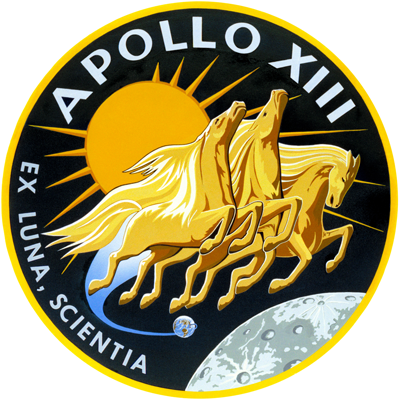
When we got the patch together ... we were the first [crew] to take the science aspect of the flight seriously. ... The idea of that patch was essentially mine. I didn’t draw it; I drew the other three patches (Gemini 7, Gemini 12 and Apollo 8). I said we wanted to do something with Apollo. I started out the design of this patch with the idea of the mythical god, Apollo, driving his chariot across the sky and dragging the sun with it. We eventually gave this idea to an artist in New York City named Lumen Winter, and he eventually came up with the three horse design which symbolized the Apollo but also included the Earth and the Moon. The funny thing is that Winter, prior to making the patch for us, made a large wall mural of horses crossing the sky with the Earth below which is prominently displayed at the St. Regis Hotel in New York City. The horses are very similar to the ones on our patch, except that it had a fourth horse falling back and that, ironically, could have been Ken Mattingly who was replaced before our flight. Anyway, we said, ‘Why put names on it?’ We decided to eliminate the names and instead put in the Latin ‘Ex Luna, Scientia’ or ‘From the Moon, Knowledge.’ I plagiarized this somewhat because it is similar to the Naval Academy ‘Ex trident, scientia’ which is ‘From the sea, knowledge.’
—Jim Lovell, from an interview with Glen Swanson published in the Spring 1995 issue of Quest, The History of Spaceflight Magazine.
Winter, a talented muralist and sculptor, executed Lovell’s commision as a bas relief sculpture, as seen below. It is lively and exciting, but completely devoid of color. NASA contract artist Norman Tiller took the bas relief image and turned it into a masterpiece of patch design, choosing the color palette that makes it so compelling.
Aside from the bald eagle — which is simply an avatar for the United States — the horses on this patch are the only animals to have made an appearance on a US mission patch up through the end of the Shuttle era.
It is an interesting coincidence that, aside from Apollo 11, this was the only flight of the Apollo series (including Skylab and ASTP) that did not include the names of the crewmembers on the patch — and that this was the only flight to have a change in crew. I imagine that later crews didn’t want to tempt fate by omitting their names!
The story of this patch has an epilogue: when the St. Regis Hotel was refurbished, Winter’s 20×8 foot mural was removed. Its location was unknown for several years before appearing at an auction of space artifacts in Los Angeles. It was purchased by Tom Hanks, who portrayed Lovell in the movie Apollo 13. Hanks then gifted the mural to Lovell, and when Lovell’s son opened a restaurant, Lovell’s of Lake Forest, near Chicago in 1999, the mural was given prominent placement in the establishment. The restaurant has now closed, and Lovell has donated the mural to the Capt. James A. Lovell Federal Health Center in North Chicago.
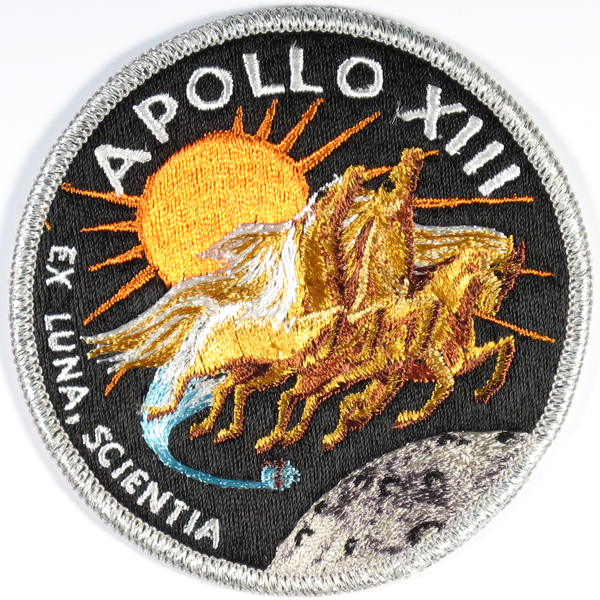
[ap13-em1]
This embroidered patch is an extraordinarily faithful rendering
by AB Emblem. The source of this patch claimed that it was 1970s vintage,
a claim that is supported by the original packaging it was in,
with a price of $1. The “ribbing” effect visible in
the sun marks this as the version worn by the crew.
91mm w × 92mm h
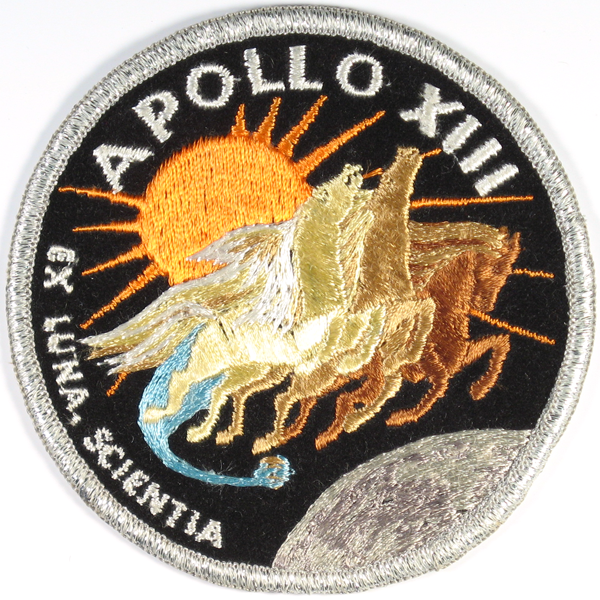
[ap13-em2]
A variant AB Emblem embroidered Apollo 13 patch. While this
is a lovely rendering, the horses are of different colors,
rather than all the same, as in the artwork. There are no craters
on the moon. Both AB and
Lion Bros patches have a silver rim, rather than orange
as in the design.
100mm dia
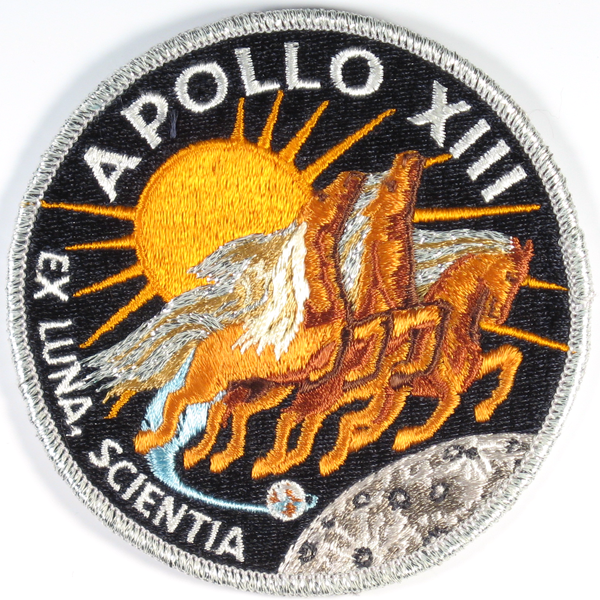
[ap13-em3]
Lion Brothers embroidered Apollo 13 patch. This rendition
follows the original artwork less faithfully than the first
AB Emblem patch ap13-em1, but more faithfully than the second
AB Emblem patch ap13-em2: the color of the three horses
are all the same (albeit too dark), and the lunar surface
shows craters. Also, the stitching of the blue contrail
is more precise.
100mm dia
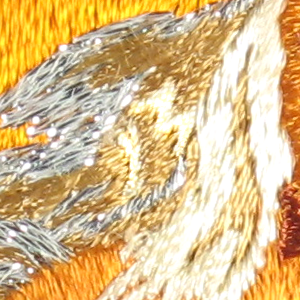
The hallmark — the number “13” stitched into a horses mane — that appears on the Lion Brothers patch.
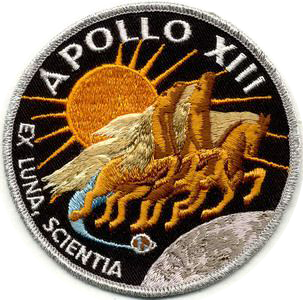
[ap13-em5]
This beautifully rendered vintage version is similar to ap13-em1
but differs in significant respects, mainly in the rendering
of the horses; but note also the halo around the earth and
the lack of black craters on the moon. Thanks to Ron Goode
for this image.

The MSC artist who produced the final artwork for the Apollo 13 patch, Norman Tiller, secreted his initials on the left foreleg of the rightmost horse — a detail too small to make it into any of the embroidered versions of the patch. It did, however, make it into the beta-cloth version — though barely legible.
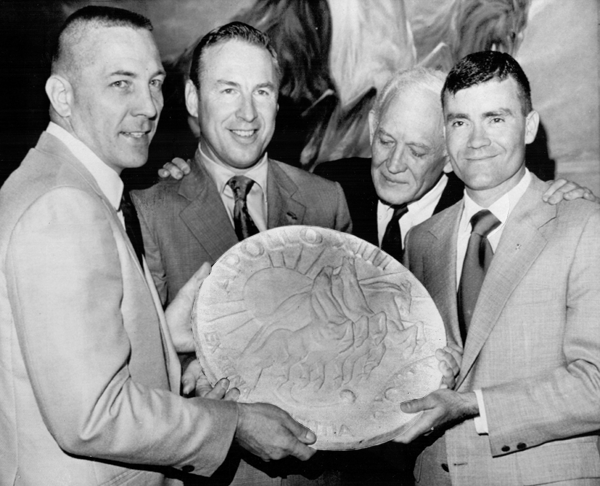
After their flight the crew joined Lumen Winter, who had created this bas-relief roundel inspired by the mural Lovell had seen. This photo (from early June of 1970) was clearly taken at the St. Regis hotel, since the mural appears in the background.

[ap13-aa1]
The 1969 mural by Lumen Martin Winter which inspired the design of
the Apollo 13 patch. Originally hung in the St. Regis Hotel, the mural
now hangs in the Capt. James A. Lovell Federal Health Care Center in
North Chicago, Ill.

[ap13-aa2]
This painting, executed by Winter in 1981, is the source for the print owned by
many collectors.

NASA photo S69-62224
Beginning with Apollo 13 it became customary to include
the crew patch as part of the official crew portrait. The
custom continued through Apollo 17. This portrait shows
the original crew, prior to the last-minute substitution
of John Swigert for Ken Mattingly.